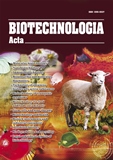ISSN 2410-7751 (Print)
ISSN 2410-776X (Online)

Biotechnologia Acta Т. 17, No. 2 , 2024
P. 67-69, Bibliography 10, Engl.
UDC:: 577.112.7:616
DOI: https://doi.org/10.15407/biotech17.02.067:
THE IMPACT OF GRAPHENE OXIDE NANOPARTICLES ON THE EXPRESSION OF ENDOPLASMIC RETICULUM STRESS-DEPENDENT GENES IS MORE PRONOUNCED IN NORMAL HUMAN ASTROCYTES THAN GLIOBLASTOMA CELLS
O.V. Rudnytska, Y.V. Kulish, O.O. Khita, Y. M. Viletska
Palladin Institute of Biochemistry of the National Academy of Sciences of Ukraine, Kyiv
Aim. The study aimed to investigate the impact of graphene oxide nanoparticles on the expression of a subset of ER stress-dependent genes in normal human astrocytes compared to glioblastoma cells, depending on the knockdown of ERN1.
Material and Methods. The culture plates with normal human astrocytes (NHA/TS) and glioblastoma cells (sublines of U87MG) were exposed to two doses of GO nanoparticles (1 and 4 ng/ml of medium) for 24 h. Total RNA was extracted from normal human astrocytes and glioblastoma cells using the TRIzol reagent. The expression level of genes related to cell proliferation was studied by real-time qPCR. Statistical analysis of the results was performed according to the widely accepted methods of variational statistics.
Results. GO nanoparticles strongly upregulated ATF3, ATF4, and TOB1 mRNA expression in both normal human astrocytes and glioblastoma cells. Still, normal cells were more sensitive to the genotoxic action of GO nanoparticles than glioblastoma cells. The changes in studied gene expressions possibly reflect these unique carbon nanoparticles' genotoxic and neurotoxic effects.
Conclusion. GO nanoparticles demonstrate a more pronounced dose-dependent effect on the expression of genes responsible for ER stress, cell proliferation, and cancerogenesis in normal human astrocytes than glioblastoma cells.
Key words: graphene oxide, mRNA expression, genotoxicity, normal human astrocytes, glioblastoma cells, ERN1 knockdown.
© Palladin Institute of Biochemistry of National Academy of Sciences of Ukraine, 2024

